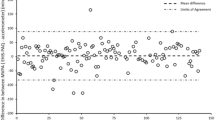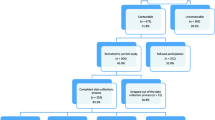Abstract
The purpose of this study was to validate a physical activity (PA) questionnaire, Questionnaire d'Activité Physique Saint-Etienne (QAPSE), in an homogenous population of elderly subjects and to estimate its potential for application in routine PA assessments in that age group. A group of 65 (31 men and 34 women) community dwelling, healthy people aged 65–84 years volunteered to participate in a validation substudy comparing maximal oxygen uptake (\(\dot VO_{2 max} \)) and anthropometric data.\(\dot VO_{2 max} \) correlated positively with mean habitual daily energy expenditure (MHDEE) (r=0.56,P<0.0001), greater than 3MET (metabolic equivalent) daily energy expenditure (DEE) activity (r=0.371,P=0.002), leisure activity (r=0.368,P=0.003), sports activity (r=0.461,P<0.0001), basic daily activity (r=0.325,P=0.008) and moving DEE activity (r=0.273,P=0.028) in both sexes, with MHDEE (r=0.366,P=0.043) and moving DEE activity (r=0.388,P=0.031) in the men and with MHDEE (r=0.624;P<0.001), greater than 3MET DEE activity (r=0.513,P=0.002), leisure activity (r=0.388,P=0.024) and sports activity (r=0.683,P<0.001) in the women. The MHDEE was positively correlated with body mass (r=0.464) and with fat free mass (r=0.639) and negatively correlated with percentage body fat (r=−0.501). In a reproducibility substudy (n=44) a paired Student'st-test, based on mean differences between the two administrations of the questionnaire did not reach statistical significance for any of the QAPSE activity scores studied. Test-retest correlation coefficients ranged from 0.648 for moving score to 0.967 for MHDEE with correlation coefficientP values being less than 0.001 for all of the QAPSE activity scores. We concluded that QAPSE demonstrated excellent repeatability and good validity in relation to physical fitness and anthropometric data in the population of these healthy elderly volunteers.
Similar content being viewed by others
References
Åstrand P-O, Rodahl K (1986) Textbook of work physiology, 3rd edn. McGraw-Hill, New York, pp 543–556
Berthouze SE, Minaire PM, Chatard JC, Boutet C, Castells J, Lacour J-R (1993) A new tool for evaluating energy expenditure: the “Q.A.P.S.E.” development and validation. Med Sci Sports Exerc 25:1405–1414
Berthouze SE, Minaire PM, Castells J, Busso T, Vico L, Lacour J-R (1995) Relationship between mean habitual daily energy expenditure and maximal oxygen uptake. Med Sci Sports Exerc 27:1170–1179
Blair SN, Haskell WL, Ho P, Paffenbarger RS, Vranizan KM, Farquhar JW, Wood PD (1985) Assessment of habitual physcial activity by a seven-day recall in a community survey and controlled experiments. Am J Epidemiol 122:794–804
Boisvert P, Washburn RA, Montoye HJ, Leger L (1988) Mesure et évaluation de l'activité physique par questionnaire. Questionnaires utilisés dans la littérature anglo-saxonne. Science Sport 3:245–262
Bouchard C, Tremblay A, Leblanc C, Lortie G, Savard R, Teriault C (1983) A method to assess energy expenditure in children and adults. Am J Clin Nutr 37:461–467
Carpenter WH, Poehlman ET, O'Connell M, Goran MI (1995) Influence of body composition and resting metabolic rate on variation in total energy expenditure: a meta-analysis. Am J Clin Nutr 61:4–10
Daugthon DM, Fix AJ, Bell CW, Patil KD (1982) Maximum oxygen and the ADAPT quality-of-life scale. Arch Phys Med Rehabil 63:620–622
DiPietro L, Caspersen CJ, Ostfeld AM, Nadel ER (1993) A survey for assessing physical activity among older adults. Med Sci Sports Exerc 25:628–642
Durnin JV, Womersley J (1974) Body fat assessed from total body density and its estimation from skinfold thickness: measurements on 481 men and women aged from 16 to 72 years. Br J Nutr 32:77–97
Folsom AR, Jacobs DR Jr, Caspersen CJ, Gomez-Marin O, Knudsen J (1986) Test-retest reliability of the Minnesota leisure time physical activity questionnaire. J Chronic Dis 39:505–511
Gaudebout C, Blayo MC (1975) Assessment of Scholander micromethod for gas concentrations versus weighing method. J Appl Physiol 38:546–549
Goran MI, Poehlman ET (1992) Total energy expenditure and energy requirements in healthy elderly persons. Metabolism 41: 744–753
Jacobs DR, Ainsworth BE, Hartman TJ, Leon AS (1993) A simultaneous evaluation of 10 commonly used physical activity questionnaires. Med Sci Sports Exerc 25:81–91
Leibel R, Rosenbaum M, Hirsch J (1995) Changes in energy expenditure resulting from altered body weight. N Eng J Med 332:628
McArdle WD, Katch FI, Katch VL (1982) Exercise physiology— energy, nutrition, and human performance. Lea and Febiger, Philadelphia
Paffenbarger RS, Blair SN, Lee IM, Hyde RT (1993) Measurement of physical activity to assess health effects in free-living populations. Med Sci Sports Exerc 25:60–70
Rising R, Harper IT, Fontvielle AM, Ferraro RT, Spraul M, Ravussin E (1994) Determinants of total daily energy expenditure: variability in physical activity. Am J Clin Nutr 59:800–804
Shephard RJ (1991) Physical fitness; exercise and ageing. In: Pathy MSJ (ed) Principle and practice of geriatric medicine, 2nd edn. Wiley, New York
Siconolfi SF, Lasater TM, Snow RCK, Carleton RA (1985) Selfreported physical activity compared with maximal oxygen uptake. AM J Epidemiol 122:101–105
Sidney KH, Shephard RJ (1977) Maximum and submaximum exercise tests in men and women in the seventh, eighth, and ninth decades of life. J Appl Physiol 43:280–287
Toth M, Gardner A, Ades P, Poehlman E (1994) Contribution of body composition and physical activity to age-related decline in peak VO2 in men and women. J Appl Physiol 77:647–652
Voorrips LE, Ravelli ACJ, Dongelmans PCA, Deurenberg P, Van Staveren WA (1991) A physical activity questionaire for the elderly. Med Sci Sports Exerc 23:974–979
Washburn RA, Jette AM, Janney CA (1990) Using age-neutral physical activity questionnaires in research with the elderly. J Age Health 2:341–356
Washburn RA, Smith KW, Jette AM, Janney CA (1993) The physical activity scale for the elderly (PASE): development and evaluation. J Clin Epidemiol 46:153–162
Yasin S, Alderson MR, Marr JW, Pattison DD, Morris JN (1967) Assessment of physical activity apart from occupation. Br J Prev Soc Med 21:163–169
Author information
Authors and Affiliations
Rights and permissions
About this article
Cite this article
Bonnefoy, M., Kostka, T., Berthouze, S.E. et al. Validation of a physical activity questionnaire in the elderly. Europ. J. Appl. Physiol. 74, 528–533 (1996). https://doi.org/10.1007/BF02376768
Accepted:
Issue Date:
DOI: https://doi.org/10.1007/BF02376768




